
First Rocket Post
Copyright
© 2022 Robert Farquharson All Rights Reserved

British Internal Airmails of the 1930’s
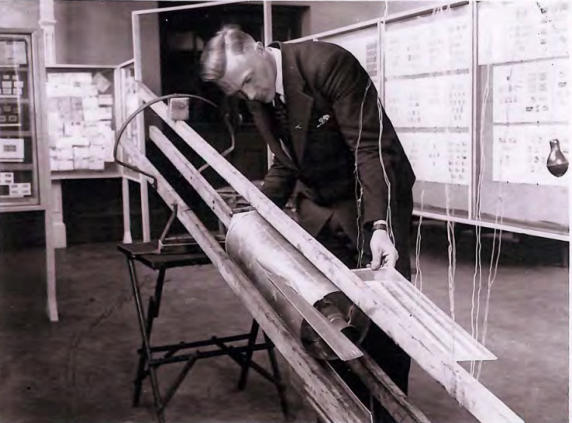
A photograph of Gerhard Zucker, the German
Inventor with his rocket in front of the 1934 “Apex
Exhibition”. Frames in London where labels were put
on sale for the first trial flight on the Sussex Downs.
These labels were the “Apex” exhibition labels
overprinted Rocket Post, First British Flight. As this
firing proved unsuccessful a second was attempted
between the islands of Scarp & Harris in Scotland,
again unsuccessful thus not to be deterred a final
and last firing was attempted from Lymington,
Hampshire to the Isle of Wight.
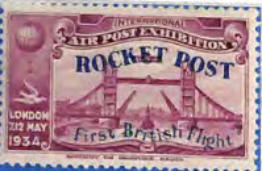
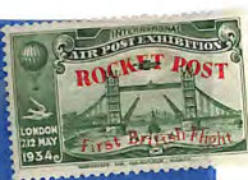

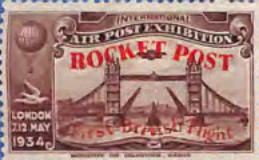
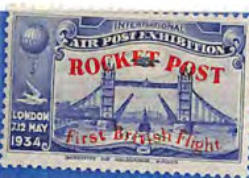
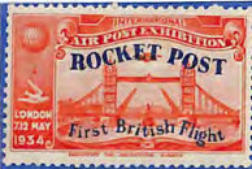
Visitors to the London Air post Exhibition (Apex), in May 1934 would have seen the German inventor Herr Gerhart Zucker with his postal rockets. A
trial firing was to be made and the labels at a cost of 2/6d each (and sold in sets of six) could have been purchased for attaching to the letters for
inclusion on the flight. However the test was delayed and eventually took place on the Sussex Downs near Rottingdean on the 6th June 1934.
The First British Experimental Rocket Post on the Sussex Downs
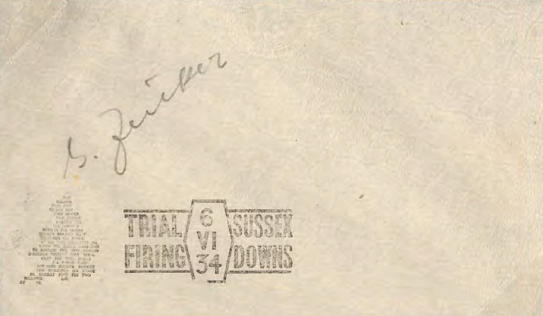
A trial impression of the Post Office cachet, note the
outline of the map of England and Wales is
composed of multiple repetition of the text; Fee two
shillings six pence paid Zucker post, and the cover
has been endorsed by Herr G. Zucker.
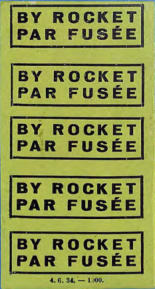
Strips of four labels were printed in Germany on the
4th June but did not arrive until after the trial had
taken place, thus covers bearing these labels printed
in Green or Red have had them added at a latter
date.
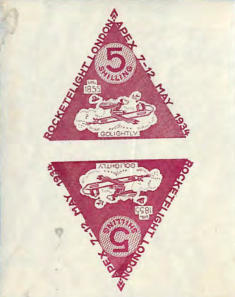
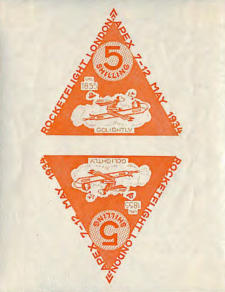
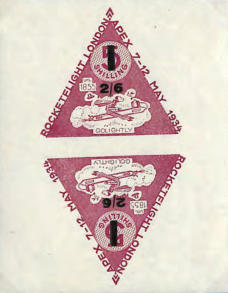
Herr Zucker prior to visiting London for the Apex Exhibition had two different triangualr labels printed unforunately they were prevented from
arriving in time due to customs delays. The 5/- value was intended for cover, the 2/6d for postcards. Only 500 pairs of the vermillion were printed
and less than 1000 of the Mauve of which 650 pairs were overprinted 2/6d.
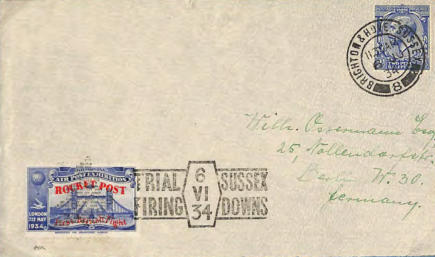
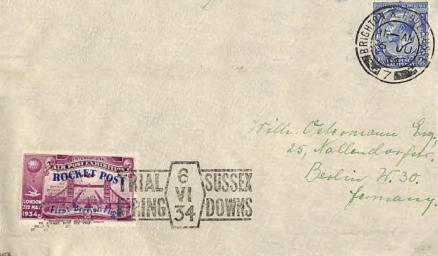
Visitors to the London International Air Post Exhibition saw one of G. Zucker’s postal rockets on display. Arrangements were being made for the
trial firing to be made during the exhibition, but this had to be delayed until early June. The Apex viginettes in six colours were overprinted by E. T.
Heron & Co and on sale for attaching to the covers, both the above being sent to Germany.
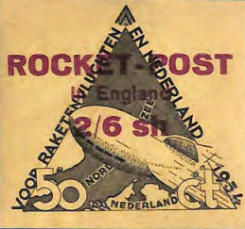
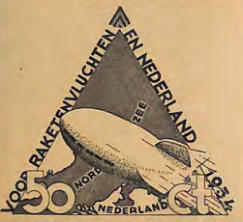
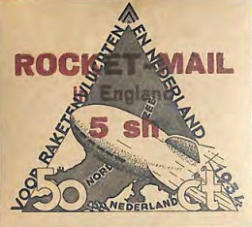
Labels on yellow paper printed in Germany for use in
the Netherlands overprinted 2/6d for postcards.
Labels on buff paper, printed in Germany for use in
the Netherlands. Overprinted 5/- for letters.
An overprinted label, brought to England in case
overprinted labels proved insufficient.
It was a great idea. Instead of labouriously loading bags into trains or cars or planes just load the bag into a rocket and
shoot it off to Ireland. It would only take three minutes. Dover - Calais would take a minute. This was Gerhard Zucker’s
dream. He would prove the methodology in a series of test flights then approach Royal Mail and offer Rocket Mail as a
commercial service. There was only one problem - it didn’t work. All three trials were failures, the most dramatic being the
second trial in Scarp in the Outer Hebrides where the rocket exploded after take-off scattering the mail far and wide, many
with dramatic burns and others into the sea where they were never recovered. The following three sections detail the
three trials complete with press cuttings describing the failures. It captured the public imagination enough for a 2004 film
to be made about the second rocket post in Scarp rather unimaginatively called ‘The Rocket Post’.
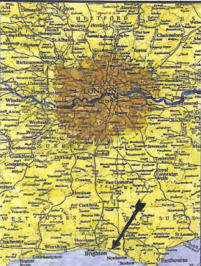
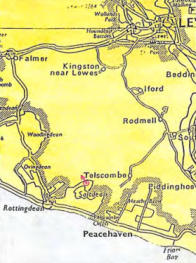
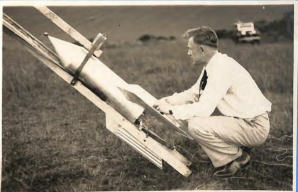
Photograph of Gerhard Zucker the
German rocket experimenter with
his rocket on the Sussex Downs
near Brighton just a few minutes
before his first trial firing on the
6th June 1934
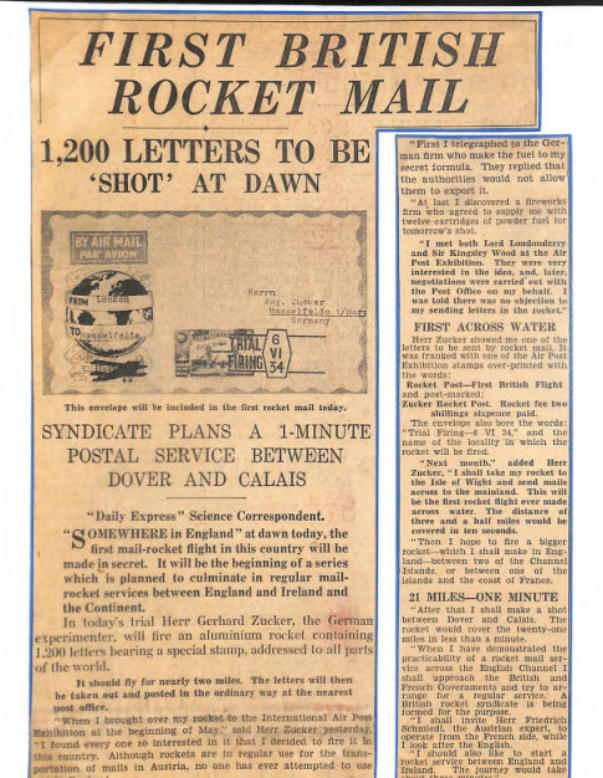
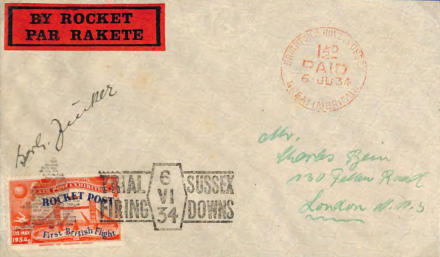
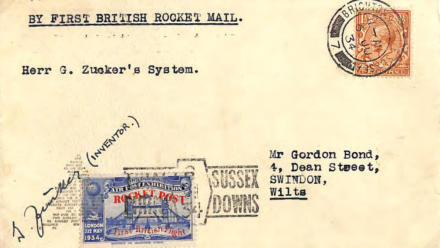
Cover cancelled by the Red Paid 1 1/2d handstamp (499 items) the values being 1 1/2d, 2 1/2d, or
4d.
Cover cancelled bu Bright & Hove double ring obliteration )371 items) of the 2864 flown.
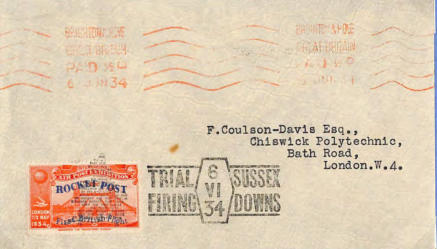
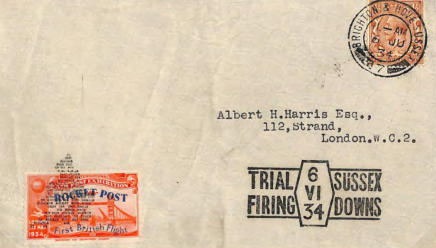
Cover cancelled by the common Red machine Obliteration (1994 items).
Cover with the Brighton & Hove double ring obliteration (371 covers) but with the cachet variety,
separated Sussex Downs and Map.
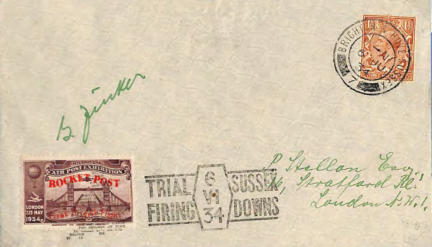
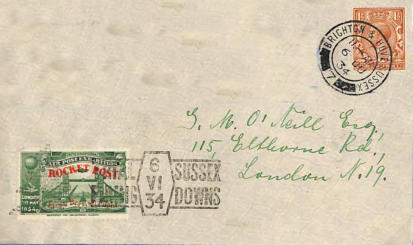
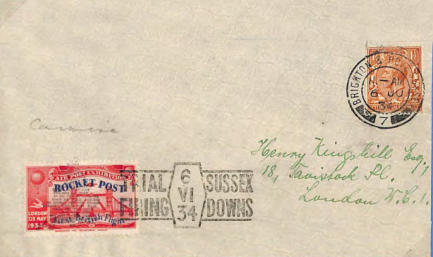
Cover signed by G. Zucker in his typical green ink.


First Rocket Post
This a curious section. It is for mail that was carried by plane but does not fit into any other service. I would love to hear from anyone who has any mail
carried by any of the five companies below, or any other airlines for which there may be souvenir mail. Below is a list and all the information I have on these
airmails. I show examples of all the mail apart from British Amphibious Airlines. The date against the entry is the first or only date that mail was flown. The
list is in chronological order of the date flown. I know also from collector records that a cover exists of a Kingsford Smith positioning flight on 11th June 1930
from Croydon to Dublin for their transatlantic flight on the 24th. I also know there is a cover carried by Olley flying services from London to Liverpool to
Dublin on March 6th 1936. Any information on these gratefully received.
25th March 1932 - British Amphibious Airlines Ltd - At least one mail sent from Blackpool to Douglas, Isle of Man.
26th August 1932 - The British Flying Boat company. At least one mail sent from Portree to Greenock.
2nd November 1933. Humber Flying Services. At least five mails sent between Hull and Grimsby.
9th August 1934. Southend Flying Services. At least one mail sent in both directions from Southend to Rochester.
12th July 1939. Pan American Airways. 6 covers taken by passenger on first flight from Southampton to Foynes.
British Amphibious Airlines Ltd
The Airline was founded by John Horseman Ltd on February 22, 1932 and managed by Lieutenant Monk who was also the pilot. Initially he took the plane from the Isle of Man and flew joy rides over Blackpool. He started a scheduled service on 18th March 1932 from Isle of Man to Blackpool, landing on the beach in both places. He flew an Avro Cutty Sark and charged £1.65 single and £3 return. Gordon Kniveton in his book Manx Aviation gives the following example of a flown mail.
There were adverts in the paper for a service from Speke in Liverpool to the Isle of Man, but this was a different company and although it did some
joyriding there was never a regular service. The service finished for the Summer in 1932 but started up again in 1933 but with less services. After closing
on the 7th October 1933, Whitehall Securities got involved and in 1935 started United AIrways to fly the same route. It does not appear that this
company flew scheduled services after 1933
The British Flying Boat Company.
This new company was registered on the 23rd June 1932, for the purpose of operating services between the Clyde and the Western Isles and to Belfast. The Chairman was the Duke of Montrose and the General Manager Lord Douglas Malcolm Hamilton. The General Manager and Flight Lieutenant J. Gordon Murray were the pilots. And on the 15th July 1932 their new amphibian the Saunders Roe Cloud G-AEIW Cloud of Iona was launched at Cowes. Later in July a proving flight was made from Greenock to Oban carrying eight passengers and then on the 15th August the company inaugurated a service from Greenock to Belfast, six passengers being carried with Lord Douglas Hamilton at the controls. This service only lasted five days and during the August 1932 Games week the Cloud of Iona was based at Portree giving joy rides. On the 26th August the Cloud of Iona took off from Portree to fly back to its home base at Greenock. The cover shown here was flown on that return flight and posted on arrival, receiving the GREENOCK RENFREWSHIRE machine cancel for 6.45 pm 25 AUG 1932. The envelope and the letter it contains, on the notepaper of the Royal Hotel Portree signed by Lord David Crichton Stuart, both indicate that it was intended to post this item of mail at Gourock. Perhaps it was landed there, but transferred to the postal system in Greenock. Although of an unofficial nature, this cover would appear to be the only flown item surviving from the pioneer activities of this little known Scottish Airline.
Hull and Grimsby Air Ferry (Humber Air Ferry)
This is the only one of the four airlines which appeared in Redgrove. He listed the Airline under East Yorkshire Motor Services, but they were the part owners along with North Sea Aerial Navigation Company and the service was never named after them. Sometimes they called themselves Hull and Grimsby Air Ferry and sometimes Humber Air Ferry. Take your pick. The service was initiated on 1st July 1933 and ran between Hendon Aerodrome, Hull and Waltham Aerodrome, Grimsby. The service ran three times daily and took 15 minutes to get from Hull to Grimsby. There was no Sunday service. There was some interest in a label they produced but as Redgrove pointed out it was just and advertising label (see below). They did fly some mail on the 2nd November 1933 when 5 covers were flown for Mr D.S. Glover. They each has a small label reading ‘HUMBER/AIR FERRY AND/CHARTER SERVICES’ The service terminated on 4th November 1933.Southend Flying Services.
In 1933 the key mover for aviation in Southend was Councillor G. E. Weber who was also the Chairman of Southend Flying Services. He was at the forefront of attempts to get the council to open a municipal airport. Southend Flying Services managed Southend Flying Club who had several Aircraft including a De Havilland 84 Fox Moth. In 1934 they explored the idea of a Service to Rochester and contacted Short Brothers the aircraft manufacturers who had a lease on Rochester Airport. On the 9th June 1934 Southend Flying Services in conjunction with Short brothers started a service to Rochester and back, 7 days a week every hour on the hour from 09.00 hours and 19.00 The service was advertised to reduce to 4 services a day in Winter but the service ended on 7th October. The Rocheford aerodrome was linked with Southend by a 7-minute bus service provided by Westcliff-on-sea motor services, who also acted as agents. At Rochester, the aerodrome was well connected by bus services to both local towns and the rest of Kent. Initially Southend Flying services provided their Fox Moth and Short brothers their new Short Scion which they were keen to advertise. Southend flying services provided their Aerodrome until they moved to the new Municipal aerodrome. Short Brothers provided Rochester Airport until it became a municipal airport later in 1934. The Short Scion was flown by Short Brothers chief test pilot J. Lancaster Parker and his assistant Harold L. Piper. The service flew to 26th October 1935 when the service ceased. By 1935 Short brothers were providing two Scions and Southend flying services had a Scion of their own. I have not been able to ascertain why the service ceased in 1935. The water crossing was 4 miles, and it took 12 minutes to fly the journey and the passenger fares were 8-shilling single, and 12- shilling return. The covers below are the only souvenir covers I have seen. If anyone has any further information, please let me know.
Southend to Rochester
Copyright
© 2020 Robert Farquharson All Rights Reserved


Label
Small timetable

Hull to Grimsby


British Internal Airmails of the 1930’s
Pan American Airways
The newly established Pan Am flights from New York to London via Foynes took place on a weekly basis. The first two flights carried only mail and guest passengers. The first westbound flight to carry fare paying passengers left Southampton on July 12, 1939. A few covers were carried from Southampton to Foynes by one of the passengers on this flight. These covers franked with 1 1/2d. postage, postmarked at the Southampton Civic Centre on July 12th, have a Foynes arrival postmark of July 13th.

































